April 29, 2016
Air Date: April 29, 2016
FULL SHOW
SEGMENTS
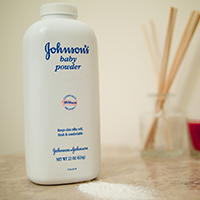
Baby Powder User Awarded Cancer Damages
View the page for this story
A jury recently awarded $72 million to the family of Jacqueline Fox, who died from ovarian cancer in October and had used Johnson & Johnson’s® Baby Powder and Shower to Shower® talc-based products genitally for decades. Johnson & Johnson had dismissed any link between talcum powder use and ovarian cancer and continued to market talcum powder to women for personal hygiene. Bloomberg reporter Susan Berfield tells host Steve Curwood why the jury found the company at fault and what’s known about the risk using talcum powder may pose to women. (10:00)
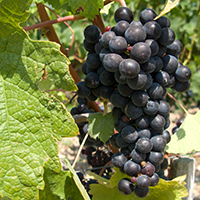
Beyond the Headlines
/ Peter DykstraView the page for this story
Host Steve Curwood and Peter Dykstra discuss news about the significance of planned floating nuclear power reactors in the South China Sea and risks from fungicide-dusted Bordeaux wine grapes before reflecting on a pivotal event in the Love Canal chemical disaster. (04:10)
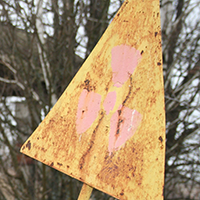
Remembering Chernobyl
/ Bruce GellermanView the page for this story
Three decades after the world’s worst nuclear power plant disaster, radiation levels in the town of Pripyat near Chernobyl have dropped. But when Living on Earth’s Bruce Gellerman went to Chernobyl ten years after the disaster, it was a different story. We revisit his report. (06:30)
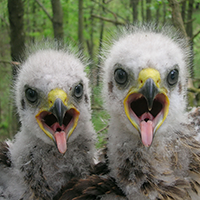
Chernobyl Wildlife Thrive 30 Years Later
View the page for this story
Host Steve Curwood speaks with Portsmouth University environmental scientist Jim Smith, who offers his perspective on the health of insect and mammal populations inside the Chernobyl exclusion zone where radiation levels vary from place to place, and where plans for the future are uncertain. (08:20)
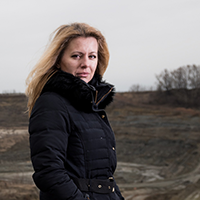
The 2016 Goldman Environmental Prizes-Part II
View the page for this story
Every year the Goldman Foundation honors six activists from around the world who have fought to protect the environment. Host Steve Curwood profiles three of this year’s winners, Leng Ouch, a Cambodian activist who exposed illegal logging operations and shut down 220,000 acres of logging concessions, Edward Loure of Tanzania, who secured communal land-rights for herders, and Zuzana Caputova from Slovakia who shut down a toxic waste dump in her home town, and prevented another from being opened. (08:45)
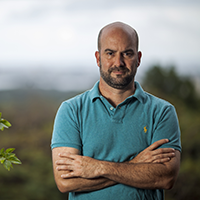
Puerto Rican Scientist Saves Leatherback Turtles and More from Hotel Development
View the page for this story
Goldman Prize winner Luis Jorge Rivera Herrera grew up surfing on a wild stretch of coast called the Northeast Ecological Corridor. Years later when he learned of plans to built two massive resorts in the area, known for biodiversity and an important nesting site for endangeredleatherback turtles, he rallied opposition to the project. Host Steve Curwood talks with Luis Jorge about his fight to protect the biodiversity of Puerto Rico. (08:30)
Show Credits and Funders
Show Transcript
HOST: Steve Curwood
GUESTS: Susan Berfield, James Smith, Edward Loure, Luis Jorge Rivera Herrera
REPORTERS: Peter Dykstra, Bruce Gellerman
[THEME]
CURWOOD: From Public Radio International, this is Living on Earth.
[THEME]
CURWOOD: I'm Steve Curwood. A St. Louis court awards $72 million to the family of a woman who died of cancer linked to a popular hygiene product – baby powder.
BERFIELD: What her lawyers had been able to show the jury is that going back really for decades, Johnson & Johnson was aware that there was science that showed an association between long-term use of baby powder and ovarian cancer.
CURWOOD: Also, 30 years after the meltdown at Chernobyl, some nearby areas are still hazardous but nature is showing remarkable resilience.
SMITH: I’ve been studying radiation for 25 years and we can’t see it, we can’t smell it, it kind of has all the elements of things that make us afraid and I think perhaps we’re more afraid than we should be; yes it’s dangerous but it’s perhaps not as dangerous as we think it is.
CURWOOD: That and more this week, on Living on Earth. Stick around.
[NEWSBREAK MUSIC: Boards Of Canada “Zoetrope” from “In A Beautiful Place Out In The Country” (Warp Records 2000)]
ANNOUNCER: Support for Living on Earth comes from United Technologies. Innovating to make the world a better more sustainable place to live.
Baby Powder User Awarded Cancer Damages

Despite renewed concerns about a possible connection between talc and ovarian cancer, Johnson & Johnson stands by its assertion that JOHNSON’S® baby powder is safe for women to use genitally. (Photo: Austin Kirk, Flickr CC BY 2.0)
[THEME]
CURWOOD: From the Jennifer and Ted Stanley studios at the University of Massachusetts Boston and PRI, this is Living on Earth. I’m Steve Curwood. Baby powder sounds perfectly safe. But last year we covered a danger that took us by surprise – the increased risk of ovarian cancer that talcum powder may pose to women who use it for personal hygiene. Johnson & Johnson marketed talc under its iconic brand Baby Powder, and at the time, numerous lawsuits had accused the company of knowing there was a risk, yet failing to disclose it to customers. Now one of those lawsuits has resulted in a finding of liability and an order for Johnson & Johnson to pay $72 million to the family of Jacqueline Fox, a daily user of its baby powder and talc-based Shower to Shower who died from ovarian cancer last October. Bloomberg reporter Susan Berfield wrote about this case and the increased scrutiny of Johnson & Johnson over baby powder, and joins me now. Susan, welcome to Living on Earth.
BERFIELD: Thanks so much for having me on.
CURWOOD: First, what attracted you to this story?
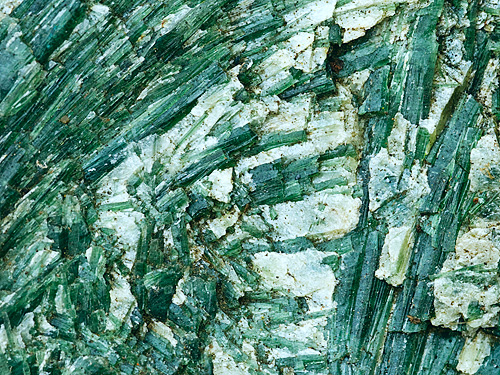
Talc can absorb both oil and water, thanks to its thin, flat crystals that repel water on the surface but absorb it at the edges. (Photo: Richard Droker, Flickr CC BY-NC-ND 2.0)
BERFIELD: I saw the news in February that a jury in St. Louis had awarded the family of the woman who ha died of ovarian cancer $72 million because there was a suspected link between Johnson & Johnson baby powder and her cancer, and I thought, “baby powder, it seems like a pretty harmless product,” and it was very intriguing to me that there was science apparently going back decades that most of us didn't know about so I started a look into it.
CURWOOD: Well, talk to me about this case, the Jacqueline Fox case. Why do you think the jury decided that Johnson & Johnson was at fault and awarded her such substantial, or rather her estate, such substantial damages?
BERFIELD: Well I think Jacqueline Fox was a very sympathetic plaintiff for the jury. She testified before she died that her mother had taught her to use baby powder, that she used it every day for her adult life, right up until the time that she was diagnosed with ovarian cancer, and what her lawyers had been able to show the jury is that going back really for decades Johnson & Johnson was aware that there was science that showed an association between long-term use of baby powder and ovarian cancer. And we should mention this is using baby powder genitaly. Johnson & Johnson had considered it to be more of a public relations problem than anything else. They didn't consider the science to be valid, but I think the jury was persuaded that Johnson & Johnson had been hiding something and that they knew of the risk, they were covering it up and that they were potentially endangering some of their most loyal customers.
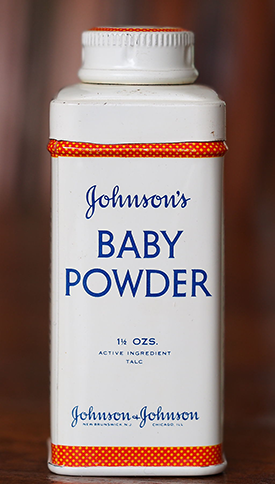
Johnson & Johnson began selling baby powder made from talc over 100 years ago. (Photo: Alf van Beem, Wikimedia Commons public domain)
CURWOOD: And how did Johnson & Johnson market baby powder to adult women?
BERFIELD: Right. So it is called baby powder. It is an important part of their baby care business and it was one of the original consumer products that Johnson & Johnson sold. It's been on the market for about 100 years and over time they realized I think that women were starting to use it, and so they shifted their advertising pretty early on, but then more dramatically in the ’60s with a variety of ads that kind of suggested if you want to feel clean and fresh, you could just kind of snatch the powder away from your baby and they specifically began targeting black and Hispanic women who they found were some of the most loyal customers. You know as overall sales of baby powder started to slow they began to look at ways in which they could sell more to their best customers. Now, you know today, and maybe even then, that sounds terrible, that they was suspicious that there could be some problem and at the same time they were increasing marketing. We saw a memo where they suggested that they should go to black churches, that they should maybe see if Aretha Franklin or Patti LaBelle would be spokespersons, and of course, neither of them agreed to that. So, they were making a very determined effort.
CURWOOD: So, at the end of the day, how significant is the risk of talc used genitally by women and a possible link to ovarian cancer?
BERFIELD: So, ovarian cancer itself is not among the most common cancers for women, but it is among the most deadly. Part of that is because it's often not detected early. So, though the odds are about 1 in 70 for most women, there have been studies that show long-term use could make those odds worse to about 1 in 53. The scientist for the plaintiffs testified that it's a significant statistical increase. On the other hand, the odds are still good that as a woman you will not be getting ovarian cancer.
CURWOOD: Why was it permissible for Johnson & Johnson to sell something which apparently had a link to ovarian cancer if they were concerned about these reports that it had this link?
BERFIELD: Yeah well, I think the science is inconsistent, and what Johnson & Johnson argues and what many groups, government groups and other studies believe is that the data that these studies have relied upon is a little iffy, there could be some bias and that the link, the statistical link is weak. There have been groups that have looked at the studies broadly and have come to that conclusion. Johnson & Johnson stands by the safety of talc. At the same time there was a ruling in 2005 by the cancer agency of the World Health Organization (WHO) which found after reviewing all of the studies that there was a possible link and that forced Johnson & Johnson's supplier to put a warning label on the talc that it supplied to Johnson & Johnson, but Johnson & Johnson still didn't feel that the evidence warranted passing on that warning to consumers.
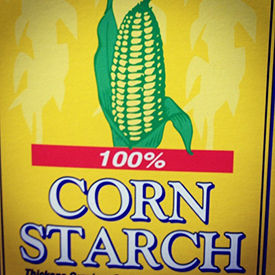
The American Cancer Society suggests that as a precaution, women use cornstarch in place of talcum powder in the genital area. (Photo: Scott McLeod, Flickr CC BY 2.0)
CURWOOD: Wait a second. You're saying when Johnson bought the talc from their supplier, it had a label saying, “there’s possible risk of cancer here”, but Johnson & Johnson decided not to put that label on what went to the public.
BERFIELD: Yes, so that I think was pretty persuasive for the jurors when they heard that.
CURWOOD: So why was it up to Johnson & Johnson to decide whether or not to put a warning on baby powder labels of this possible risk of ovarian cancer?
BERFIELD: Right. Cosmetics are mostly unregulated. The Food and Drug Administration doesn't really have the authority over cosmetics. That is a law that goes back to the 1930s, and it's also one that a lot of consumer groups, as well as members of Congress, are trying to update to give the FDA more authority, hopefully more funding, to require some additional safety precautions by the big cosmetics companies. But right now there's not very much, you know it's self-regulating.
CURWOOD: As I understand it Johnson & Johnson also sells a cornstarch only baby powder, and apparently there's no concern about cornstarch being linked to ovarian cancer. Why wouldn't the company simply switch over entirely to cornstarch?
BERFIELD: It is a really good question that I asked and didn't get an answer but what I could deduce is that they may have some concerns about how well cornstarch works to do what baby powder is supposed to do, which is keep babies dry and make them smell clean and fresh. That's what they’ve said that it doesn't quite measure up, but in many other cases in recent years Johnson & Johnson has yielded to consumer concern about chemicals in baby products in particular. They have made pledges to remove the formaldehyde from baby shampoo, phthalates, parabens, and other chemicals from their products, and in those cases they've stated is that we believe those products are safe or we are using them in amounts that are safe, but we also understand that consumers have concern and we want consumers to have peace of mind so we're removing these. And it is a little hard from the outside to understand why Johnson & Johnson wouldn't just switch over to the product that it already sells, but I think at this point Johnson & Johnson is tied up in a lot of litigation over this. There have been two cases that have gone to trial. There's a third one that's underway, but there's probably about 1,200 more and I think faced with that they're making some different calculations.
CURWOOD: In 2015 we reported on a lawsuit that Deane Berg won against Johnson & Johnson. The company was found liable for not warning the risk of ovarian cancer, but there were no damages awarded. What you make of the fact that Jacqueline Fox's family in contrast was awarded $72 million yet Berg was awarded nothing?
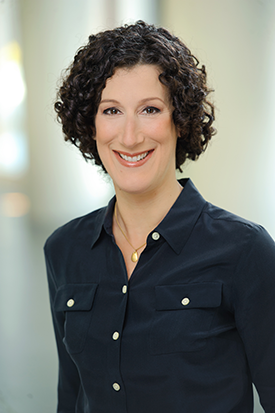
Susan Berfield writes for Bloomberg Businessweek and is based in New York City. (Photo: Bloomberg)
BERFIELD: I think it speaks to the variation among juries really. They saw mostly the same evidence, and there's another important distinction between the two cases and that is that Deane Berg is alive, Jacqueline Fox died just in the months before the trial began. I think Jacqueline Fox in general was a very sympathetic plaintiff because she had used it so long because she had died. She was black and the jury heard the evidence that we spoke about before in terms of Johnson & Johnson marketing it to black women, and I think all of that factored into their decision to award to $72 million judgment.
CURWOOD: Susan Berfield is a reporter with Bloomberg BusinessWeek in New York City. Thanks so much, Susan.
BERFIELD: Thank you very much.
CURWOOD: Johnson and Johnson says it was disappointed by the ruling, and that it firmly believes the safety of cosmetic talc is supported by decades of scientific evidence. Their full statement is on our website, LOE.org.
Johnson & Johnson statement on Jacqueline Fox verdict:
“The jury decision in the Fox trial goes against decades of sound science proving the safety of talc as a cosmetic ingredient in multiple products, and while we sympathize with the family of the plaintiff, we strongly disagree with the outcome and are in the process of appealing the verdict. The overwhelming body of scientific research and clinical evidence supports the safety of cosmetic talc.”
Related links:
- Susan Berfield’s Bloomberg article, “Johnson & Johnson Has a Baby Powder Problem”
- Our previous story on the possible link between talc and ovarian cancer
- Johnson & Johnson’s statement on the safety of talc
- The American Cancer Society on talcum powder and cancer
- About ovarian cancer
Beyond the Headlines
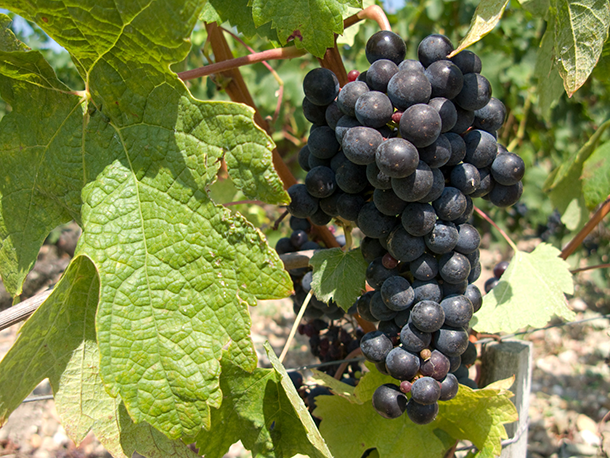
Studies show an increased rate of illness among vineyard workers in the Bordeaux region of France. (Photo: TOMOYOSHI, Flickr CC BY-NC-ND 2.0)
CURWOOD: We’ll join Peter Dykstra of Environmental Health News, EHN.org and DailyClimate.org now, and check out what’s notable beyond the headlines. Peter’s on the line from Conyers, Georgia as usual. Hi, Peter!
DYKSTRA: Hi, Steve. Would you care for a little wine?
CURWOOD: Well, you do some whining here just about every week Peter.
DYKSTRA: No, no no — wine, W-I-N-E, specifically the legendary wine of Bordeaux. For the last seven years, there’s been a feud fermenting over the impacts of pesticides used in some of the most storied vineyards in the world. When a vineyard worker died of a very rare cancer back in 2009, his sister started asking questions and found high disease rates among winery workers in Bordeaux. Some folks suspect a fungicide that’s used on Bordeaux grapes. They’re calling for a ban or restrictions and recently a documentary increased the focus on all of this in France.
CURWOOD: Bordeaux, I believe that’s the largest wine-producing area in France. Should consumers be worried?
DYKSTRA: Well there was a study a few years back that concluded the pesticide risk to wine drinkers was negligible — you’d have to drink enough Bordeaux that you’d be flat broke and you’d probably have other problems beside the chemicals — but vineyard workers and neighbors might have substantial risks from constant exposure. The wineries and regulators say they’ll look at restricting the fungicide use near homes and schools, but others say that’s too little and too late so let’s stay tuned to this one.
CURWOOD: We will. Hey, what’s next?
DYKSTRA: China is hatching plans to build floating nuclear power plants in the South China Sea. And you that sounds kind of scary in a “What Could Possibly Go Wrong” kind of way, right? But whatever one thinks of nuclear power, you can’t say that this is unprecedented, since there are already about 200 floating nuclear reactors in operation. They’re called aircraft carriers, submarines, and icebreakers.
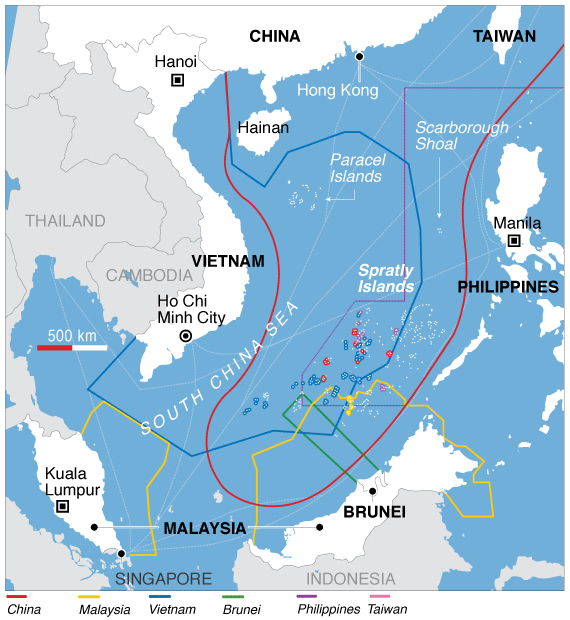
China is making big territorial claims in the South China Sea, outlined in red, much to the chagrin of the superpower’s smaller neighbors. (Photo: Voice of America [Public domain], via Wikimedia Commons)
CURWOOD: And you know it is one way to have plenty of water to stop an accidental meltdown. And China is leading the world in the development of small modular nuclear power reactors. So, what’s the big deal then?
DYKSTRA: Well this one’s controversial in a very different way and a hugely important way: the reactors are part of China’s apparent attempt to colonize a shared body of water that’s one and a third million square miles. It’s caused an immense conflict with other nations that border the South China Sea and have territorial claims of their own, like Taiwan, the Philippines, Malaysia and Vietnam.
CURWOOD: Yeah, those neighbors aren’t too happy with China building military bases on the artificial islands on that disputed part of the ocean.
DYKSTRA: It’s the biggest foreign policy flare-up in that region in decades. And let’s compare it to what might happen here that would be similar. China’s effort to capture the South China Sea is like if the U.S. told Canada to keep its mitts off the Great Lakes.
CURWOOD: That certainly wouldn’t go over well. What do you have from the history vault this week?
DYKSTRA: Well what Chernobyl was to nuclear disasters, Love Canal was to chemical ones — and you know, It was intended to be an actual Canal, a shipping route around Niagara Falls but the builder, one William T. Love, went bust in the 1890’s and left a big, dry hole in the ground. Love Canal was used as a dump for garbage and chemical waste until it was filled in and closed in 1953. And 63 years ago this week, the owners of Love Canal at the time — the Hooker Chemical Company — in an act of runaway decency sold the site to the Niagara Falls Board of Education, for one dollar.
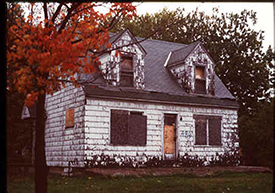
The delayed government response to the Love Canal included the evacuation of about 800 families. (Photo: EPA [Public domain], via Wikimedia Commons)
CURWOOD: Hmm, a dollar? Sounds like it would be a deal — but I don’t think it turned out that way?
DYKSTRA: No indeed — as part of the deal, the school board promised to never sue Hooker Chemical if something went wrong with building an elementary school in a working class neighborhood on top of a half-century’s worth of chemical waste.
CURWOOD: And this would be where Lois Gibbs, who’s been on our program several times over the years, enters the picture.
DYKSTRA: She did and this was in the 1970’s when there was a rash of illnesses, many of them quite serious, in the Love Canal neighborhood and citizen-activist Lois Gibbs emerged to lead her very angry neighbors in demanding cleanup and justice. The school was bulldozed, over 800 homes were bought out, and the disaster inspired the Federal Superfund cleanup program, which labors on with mixed results to this very day.
CURWOOD: Peter Dykstra’s with Environmental Health News, that’s EHN.org and the DailyClimate.org. Talk to you soon, Peter.
DYKSTRA: Alright, Steve, thanks a lot, we’ll talk to you soon.
CURWOOD: And you can see more on these stories, including the actual deed to Love Canal, on our website LOE.org.
Related links:
- Study: Wine Pesticides A Danger To Winegrowers
- ChicagoTribune: “China to build nuclear power plants on artificial islands”
- The history of Love Canal
- Love Canal Deed
[MUSIC: Bruce Springsteen and The Sessions Band, “Erie Canal,” We Shall Overcome: The Seeger Sessions, Thomas S. Allen (1905), Columbia Records]
CURWOOD: Just ahead...the ecological legacy of the world’s worst nuclear power plant disaster...not all the news is bad. Stay tuned to Living on Earth.
ANNOUNCER: Support for Living on Earth comes from the Gordon and Betty Moore Foundation, and from Wunder Capital, an online investment platform that allows individuals to invest in solar projects across the U.S. More information and account creation at Wunder Capital.com That's Wunder with a 'U'. Wunder Capital, Do well and do good.
[CUTAWAY MUSIC: Fabian Beghin/Didier Laloy, “Frost Waltz,” Cryptonique, Homerecords]
Remembering Chernobyl
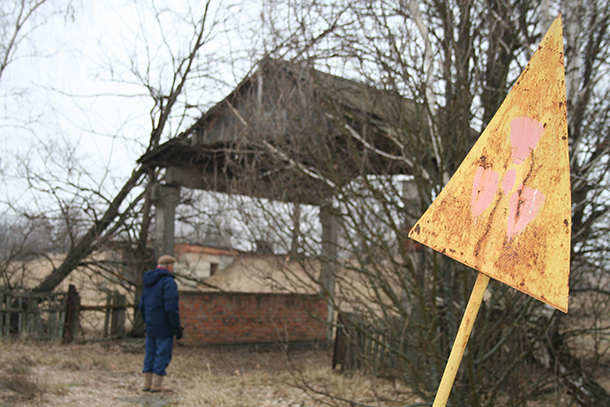
A sign bearing the universal radiation symbol rusts in the Chernobyl Exclusion Zone. (Photo: Scott, Flickr CC BY-SA 2.0)
CURWOOD: It’s Living on Earth, and I’m Steve Curwood. Thirty years ago, on April 26th 1986 at 1:23 a.m., local time, a steam explosion at the number 4 reactor at the Chernobyl plant in the Ukraine led to the worst ever nuclear power plant accident. With its cooling water gone the graphite core of the Soviet reactor ignited and the uranium fuel rods vaporized, sending a plume of radioactivity high into the atmosphere.
Soviet officials said nothing for nearly 2 days, then Swedish authorities detected the radiation and Russian TV news made a short announcement:
[SFX - Russian newscast: "An accident has happened at the Chernobyl Nuclear Power Plant. One reactor has been damaged. The government has formed a commission of inquiry.]
CURWOOD: The delay meant the workers and their families who lived in the city of Pripyat just nine miles from the plant received high doses of dangerous radiation, before the order came to evacuate.
[SFX - Announcement in Russian: "Attention, attention, dear comrades, to insure your safety and especially the safety of your children it is necessary to temporarily evacuate the city and surrounding areas in the Kiev region…"]
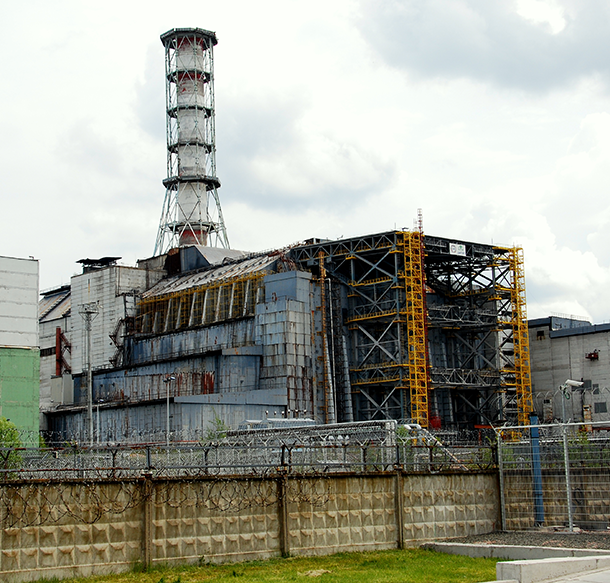
The Chernobyl Nuclear Power Plant (Photo: Fi Dot, Flickr CC BY-SA 2.0)
CURWOOD: What was initially billed as a three day evacuation has lasted 30 years, and Pripyat today is a derelict ghost town, still off-limits to most people, though it’s a popular tourist destination now, as the radiation levels from decay elements of Strontium 90 and Cesium 137 have dropped as they reach their half-lives. But when Living on Earth’s Bruce Gellerman first visited on the 10th anniversary of the disaster it was a different tale – here’s part of his report.
[SOUND EFFECTS OF THE ROAD]
GELLERMAN: It’s a 2-hour drive from Kiev to Chernobyl along rolling hills and peat bogs. Ukrainians say that the soil here is so rich that you can eat it, at least that’s what they used to say. Today a thousand square miles around the plant is off limits to most people.
[SPEAKING IN RUSSIAN]
TRANSLATION: There’s a sign that says it’s impossible to live here constantly…
GELLERMAN: 18 miles from Chernobyl, we enter the exclusion zone. My driver Pietro is quiet as we enter the zone past empty farms, homes, churches and schools. A week after the disaster, 135,000 people were permanently removed from this area.
[SPEAKING IN RUSSIAN]
TRANSLATION: It is our tragedy. This was a very good place to live, what can we do? This is our fate.
GELLERMAN: To visit Chernobyl requires special permission and an official guide. We are joined by a plant technician who will monitor radiation levels - he sees the look in my eyes.
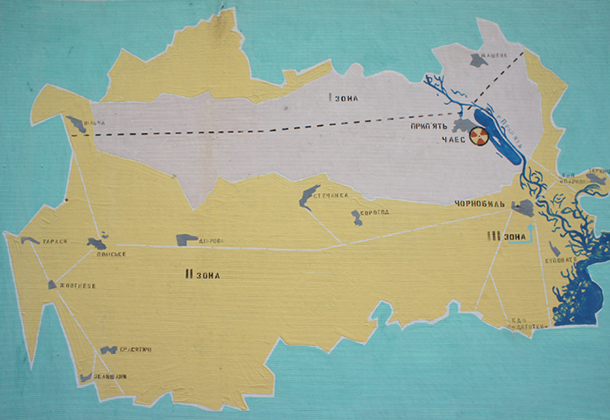
Map of exclusion zone (Photo: super collider, Flickr CC BY 2.0)
[GUIDE SPEAKING IN RUSSIAN]
GELLERMAN: He says we’re completely safe; still, I’m given special clothes to wear. A Russian hat, burly coat, cotton socks, gloves, leather boots and a facemask, just in case.
[WALKING SOUNDS]
GELLERMAN: A faded mural on a vacant apartment building welcomes us to Pripyat, the town was once home to 45,000 residents - plant workers and their families. The sign reads: The party of Lenin leads us to a Communist victory. My guide Alexander Shevchenko deadpans an old party slogan: The people of Pripyat really did invite the friendly atom into their homes. He laughs alone in the silence.
[BEEPING SOUNDS]
GELLERMAN: But for our Geiger counter, the apartments are ghostly quiet. Plant officials delayed the evacuation of Pripyat by a day and a half. By then, Alexander says, the clouds of radioactive iodine had delivered intense doses to the town’s children.
[BEEPING SOUNDS]
GELLERMAN: Why did they wait 36 hours before they evacuated?
SHEVCHENKO: They waited for the order from Kremlin. They knew about the danger, but they waited for the instructions. I think it is forever, it shouldn’t be forgotten.
[DOOR CREAKS, WALKING SOUNDS]
SHEVCHENKO: How to forget it? How to forget this abandoned city.
[DRIVING, WIND NOISES, VOICES IN RUSSIAN]
GELLERMAN: The radiation readings jump as we pass the remains of a contaminated forest buried in a field. It’s a two-mile ride from Pripyat to the plant. Chernobyl dominates the desolate marshland. It’s a white, windowless monolith - a mile long and nearly a football field high.
[SOUNDS OF PEOPLE GETTING OUT OF THE CAR]
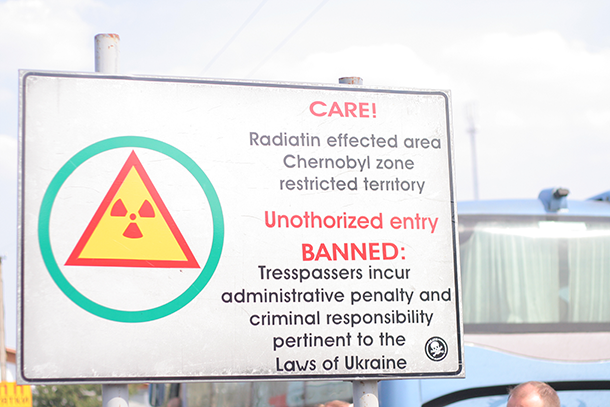
A sign at the Chernobyl exclusion zone checkpoint warns visitors not to trespass (Photo: Clefty, Flickr CC BY-NC 2.0)
GELLERMAN: We’re standing at Ground Zero. Today, what remains of the melted number four reactor is entombed in a massive 24-story sarcophagus. But even 300,000 tons of steel and concrete can’t contain the intense radiation within.
[TALKING IN RUSSIAN]
GELLERMAN: The levels on our Geiger counter double when point it at the sarcophagus - it’s the most radioactive building on the planet. The amount of radiation released at Chernobyl was 250 times that of the atomic bombs dropped on Hiroshima and Nagasaki combined. After a minute here, Alexander wants to leave this place.
[TALKING IN RUSSIAN]
SHEVCHENKO: We better get back to the car?
GELLERMAN: Why’s that?
SHEVCHENKO: Because it’s rather high. You know, I‘ve been inside the sarcophagus is four times.
GELLERMAN: What is it like? What does it look like inside?
SHEVCHENKO: The ruins. Ruins, wrecks, and high levels of radiation. Only two minutes allowed.
CURWOOD: That was Alexander Shevchenko, who acted as a translator for Living on Earth’s Bruce Gellerman when he reported from the wrecked Chernobyl plant in 1996, just ten years after the disaster.
Related links:
- Listen to Bruce Gellerman’s original Chernobyl report from 1996
- More about the Chernobyl Nuclear Accident from the International Atomic Energy Agency
Chernobyl Wildlife Thrive 30 Years Later
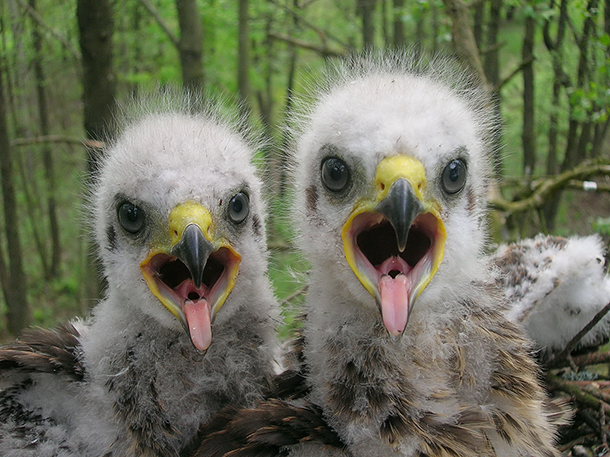
Two eaglets born within the borders of the Chernobyl exclusion zone (Photo: Valeriy Yurko)
CURWOOD: It’s 30 years on now, and though nobody lives in the crumbling apartment buildings in Pripyat, thousands continue to work at the wrecked plant to maintain its safety. And since the disaster, plenty of research is being carried out on the continuing effects of the catastrophe. Among those researchers is James Smith, professor of Environmental Science at Portsmouth University in the UK.
SMITH: I first went there in 1994 and at the time we were studying the transfer of radioactivity in aquatic ecosystems, so in lakes and rivers around the zone and around the power station, and we were looking at how the radioactivity got into the rivers and lakes, how long it was going to be there, and how it got taken up by the aquatic food chains.
CURWOOD: So how much in the way of contamination did you find in those early years?
SMITH: So in the first few weeks and months after the accident the radioactivity in the rivers and lakes went down very quickly because a lot of the radio nucleides, a lot of them decayed very quickly after the environment, but radio cesium which is the one that we're all worried about at the moment because it has a 30-year half-life - it's around in the environment for a long time - that accumulates in the aquatic food chain. So broadly what we've found after Chernobyl was what people had seen after the nuclear weapons testing was this high bioaccumulation of radioactive cesium, not just in fish, but in many foodstuffs.
CURWOOD: And what else did you look at in terms of organisms?
SMITH: We've looked at aquatic insects. So we did a study together with some biologist colleagues of mine to look at the communities of what we call invertebrates, so little insects that live in the sentiments of these lakes...how are they faring after the big radioactive release?
CURWOOD: So I'd have to ask you...are the bugs being bugged?
SMITH: Apparently not. We studied eight lakes of different levels of contamination. So some of them near natural background radiation levels and up to a lake called Glubokoye which is most contaminated lake we studied at Chernobyl and we didn't find any difference in the aquatic insects in the different likes and in fact Glubokoye, it wasn't statistically significant but it did have the highest diversity and abundance of aquatic insects.
CURWOOD: Hmmmm, interesting, Now, you continue to go back. How aware of you of radiation levels dropping, and how does that affect the health of the wildlife, do you think?
SMITH: Well, we've also looked at mammals in the exclusion zone. So the exclusion zone, it's about 4,000 square kilometers of land, and roughly half of it is in Ukraine and half of it is in Belarus to the north of Ukraine. And we worked with our Belarusian colleagues who studied their sector of the zone, so their half of the exclusion zone, and we found in a paper that we did last year the mammal communities are doing very well. The Belarusians have used helicopters to survey the zone for wild boar - I think you call them hogs in the United States - roe deer and elk. And what they found was an increase in population from about one to two years after the accident, up to 10 years after the accident.
CURWOOD: It seems to me that the wildlife is doing OK. How safe would it be for people to move back there?
SMITH: Most levels of radiation, even if they're very high at Cherynobyl at the moment, it's quite a small risk, but it's a risk that often humans don't choose to take. The exclusion zone is only habited because we consider the risk of say, one in a 1,000, risk of cancer in human life is not a risk that it's fair for a person to have. So that's why the exclusion zone’s uninhabitated. But, for a mammal population, so a population of wolves or a wild boar, this relatively small risk doesn't affect the population, although on rare occasions it might affect an individual.
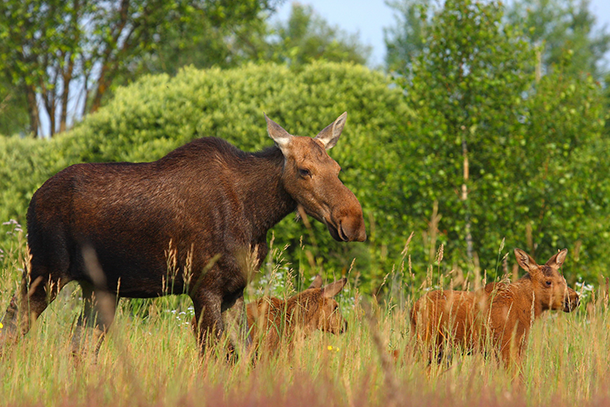
A family of moose who have made the Exclusion Zone their home (Photo: By Tatyana Deryabina)
CURWOOD: I have to ask you, when you go there, what do you wear in terms of dosimeters? Something on your body to tell you how much radiation you got?
SMITH: Yeah we always wear a dosimeter, usually we go for about two weeks, and we go to various spots, we're not in the hotspots all the time. And I get a dose of about 0.1 or 0.2 milisieverts, and that probably doesn't mean much to most people...
CURWOOD: It doesn't. Tell me, what does it mean?
SMITH: So, in the UK, we get about 2.7 milisieverts every year from natural radiation and from X-ray diagnostics, so it's about 20 times lower than I'm getting in the UK. So the radiation doses now in the exclusion zone, there are some real hotspots to be very careful of, but they are quite small and most of the zone you can go on a two-week visit and you don't get too big a radiation dose.
CURWOOD: So, of course, you don't research on humans directly. Your perspective on the effects of human health from this accident?
SMITH: People are always understandably interested in what the human consequences have been, but statistically, it's going to be very difficult to see that because we can't distinguish between a cancer that's come from radiation and a cancer that's come from other causes. So unfortunately, in developed countries about a quarter and a third of people die from cancer. It's very difficult to see this small increase of risk of cancer from Chernobyl amongst the "natural" cancers, if you like. So, I think statistically we'll probably never know how many people have died from Chernobyl, but the estimates have been in the, say, 8,000 people.
CURWOOD: Now, there was quite a flap about the question of thyroid cancer, of course, which is something that affects young people as well. So, that type of cancer, to what extent do you see that among animals?
SMITH: I don't think that there have been any studies of that. I don't think anyone has really looked at that. It's clear as you say, in a big increase in thyroid cancer in Belarus since the accident, so there have been several thousand cases since the accident and that was primarily due to the fact that the Soviet Union then didn't take enough precautionary measures to stop people eating contaminated milk, contaminated produce, after the accident. Fortunately, thyroid cancer’s one of the more treatable cancers, but it is still a serious disease.
CURWOOD: Now, I know this isn't your particular area of expertise, but there appear to be different suggestions as to the area's future. Some are suggesting to use it to store high level waste or others say, “hey, it should just continue as a nature reserve.” Where does the debate stand from your understanding?
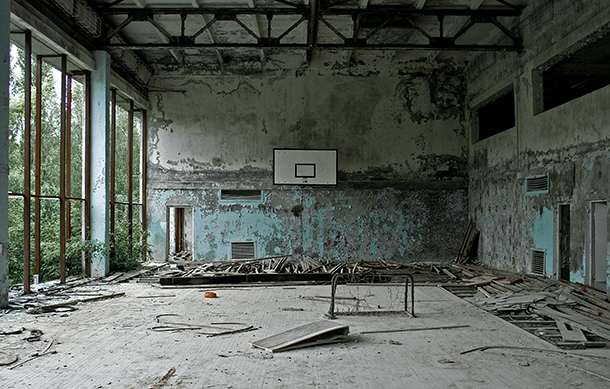
A public gymnasium that was abandoned after the nuclear disaster (Photo: Phillippe Simpson, Flickr CC BY-NC 2.0)
SMITH: I think we're getting conflicting views from various people in Ukraine on this. A few weeks ago the Ukrainian government declared the zone as a nature reserve which it kind of has been because the animals of been protected by the fact that there aren't people there, but also there's discussion about using it as a waste storage site. I'm not a geologist so I can't comment on the geological suitability of the site, but from a human perspective it makes a lot of sense to me because people quite understandably don't like waste, nuclear waste sites, next to their houses. As it is, I don't think people will go and live there again. People understandably don't particularly want too many people, so I think the exclusion zone will remain pretty much as it is, as a kind of strange wildlife reserve.
CURWOOD: As far as you've seen, it seems that nature's pretty resilient. How fair is that observation?
SMITH: I think that's true, I mean you could say that radiation is perhaps not bad as we think. I've been studying radiation for 25 years and thinking and talking to people about it, and thinking about how we perceive it and it's something that we are naturally frightened of quite understandably because we tend to associate it with the horrible nuclear bombs in Hiroshima and Nagasaki, very awful events like Chernobyl and the Fukushima accident. We can't see it, we can't smell it, it kind of has all the elements of things that make us afraid, and I think perhaps we're more afraid than we should be. Yes, it's dangerous, but it’s perhaps not as dangerous as we think it is.
CURWOOD: Jim Smith is a professor of Environmental Science at Portsmouth University in the UK. Thanks so much, Jim, for taking the time.
SMITH: OK. Pleasure.
Related links:
- Listen to Bruce Gellerman’s original Chernobyl report from 1996
- Study: Thyroid Cancer Incidence Following the Chernobyl Disaster
- Eleven of the worst nuclear accidents globally
- U.N. Document on the Human Consequences of Chernobyl
- About Jim Smith
[MUSIC: Geoff Bartley, “Moonset,” Blackbirds in the Pie, Joshua Omar’s Music/MCR]
CURWOOD: Coming up...winning the fight to protect turtle nests and indigenous land rights. That's just ahead on Living on Earth. Stay tuned.
ANNOUNCER: Funding for Living on Earth comes from United Technologies, a provider to the aerospace and building systems industries worldwide. UTC Building & Industrial Systems provides building technologies and supplies container refrigeration systems that transport and preserve food and medicine with brands such as Otis, Carrier, Chubb, Edwards and Kidde. This is PRI, Public Radio International.
[CUTAWAY MUSIC: Joe Derrane/Zan MacLeod, “Caprice,” The Tie That Binds, Joe Derrane, Shanachie Records]
The 2016 Goldman Environmental Prizes-Part II
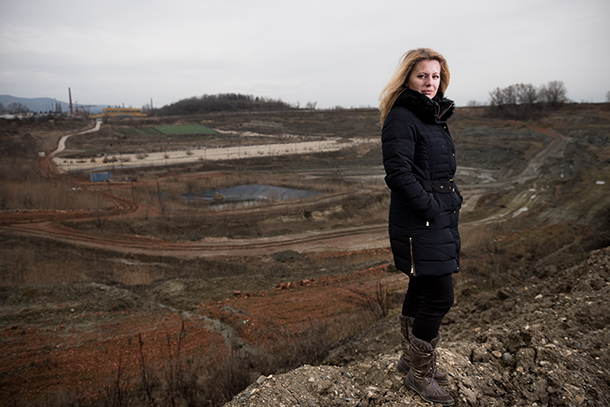
Slovakian Zuzana Caputova, 2016 Goldman Prize Winner from Europe (Photo: Goldman Environmental Prize)
CURWOOD: It's Living on Earth, I'm Steve Curwood. This week we continue our coverage of the 2016 Goldman Environmental Prize winners. The Prize is awarded each year to six grassroots activists who are champions of the natural world, with winners selected from each of the five inhabited continents plus an island nation or territory. Earlier we profiled winners Maxima Acuña, a farmer in Peru who fought a massive gold mine, and student Destiny Watford, who mobilized opposition to a bid to build a huge polluting trash incinerator in South Baltimore. Now we turn to Zuzana Caputova, a public interest lawyer from Slovakia, who spoke at the prize ceremony in San Francisco.
CAPUTOVA: Good evening ladies and gentlemen, thank you for the honor to be here with you tonight. Let me express my deepest gratitude to the Goldman Environmental Foundation, your award is a great encouragement for me, as well as hundreds of other people in Slovakia.
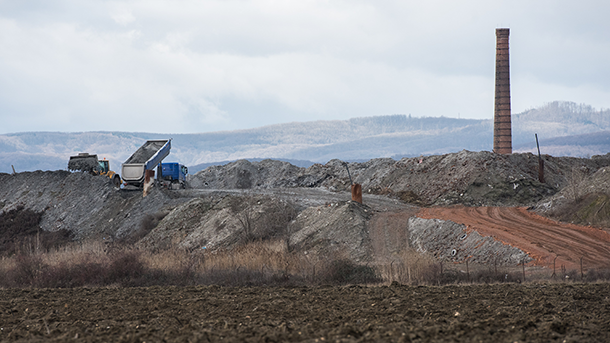
Caputova fought to close a poisonous dump in her hometown and prevent the opening of a new landfill (Photo: Goldman Environmental Prize)
CURWOOD: Ms. Caputova led a campaign to shut down an old toxic waste dump and stop the construction of a new one in her hometown of Pezinok, where leukemia rates are 8 times higher than the national average. She combined grassroots activism and legal strategies to fight the landfills, and in 2013 the Supreme Court of Slovakia ordered the old landfill shut down and cancelled the permit for the new one. The ruling affirmed an earlier decision by the EU Court of Justice, and underscored the right of the public to participate in environmental decision-making throughout the European Union.
CAPUTOVA: [APPLAUSE] Our story has given hope to many other people who fight against reckless developers. In Slovakia we are still learning lessons about democracy after the fall of communism, but no country has democracy working well on autopilot. [APPLAUSE] We cannot let it run without our involvement; the same goes for the protection of our planet, it needs engagement. Thank you. [APPLAUSE]
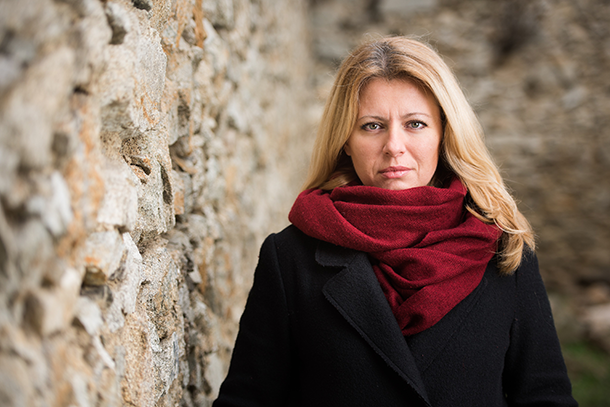
Caputova’s victory clarified rules throughout Europe on public participation on decisions affecting the environment (Photo: Goldman Environmental Prize)
CURWOOD: Holding governments accountable for upholding the rights of their people was a theme of this years’ winners, including Leng Ouch, who is fighting against deforestation in Cambodia.
OUCH: [APPLAUSE] Thank you, ladies and gentlemen. Today I’m very grateful for the opportunity to tell you about the real situation in Cambodia.
CURWOOD: Leng Ouch grew up in a family of poor farmers living in the forest during the brutal Khmer Rouge dictatorship. He won a scholarship to attend law school and after graduating founded the Cambodia Human Rights Task Force to fight illegal logging and protect land rights.
Leng Ouch went under cover as a timber dealer, driver, and tourist, putting his life at risk in order to expose Cambodia’s illegal logging crisis to the world. His photographs and videos showed collusion between the Cambodian government and illicit loggers. Eventually the government was forced to cancel 23 concessions that had been granted to illegitimate logging operations, effectively protecting 220,000 acres of forest.
At the Goldman prize ceremony Mr. Ouch called on the world community to keep up the pressure on the Cambodian government.
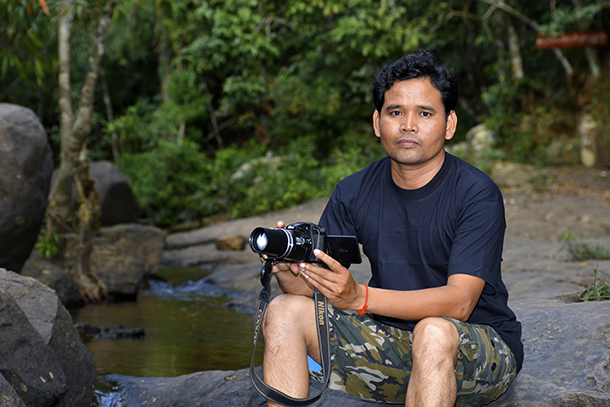
Cambodian Leng Ouch, Goldman Prize Winner 2016 from Asia (Photo: Goldman Environmental Prize)
OUCH: I would like to ask all of you to participate in our campaign and tell your government to use their influence in Cambodia to end exploitation in our land. [APPLAUSE] The forest does not belong to only me, it also belongs to you and it also belong to the people around the world. Ladies and gentlemen, please join us to help fight illegal logging Cambodia. [APPLAUSE]
CURWOOD: We also spoke with some of Goldman prize winners before the awards ceremony.
LOURE: My name is Edward Loure. I come from Tanzania, and I work with an organization called Ujamaa Community Resource Team.
CURWOOD: Edward Loure is a member of the cattle-herding Maasai people. And his Ujamaa Community Resource Team works to secure land rights for Tanzanian pastoralists and hunter-gatherers like the Maasai and the Hadzabe. As a child his family was pushed off their land when Tanzania created the Tarangire National Park, now considered a premier wildlife reserve.
Edward Loure says that too many indigenous people have been relocated off their lands to make way for parks.
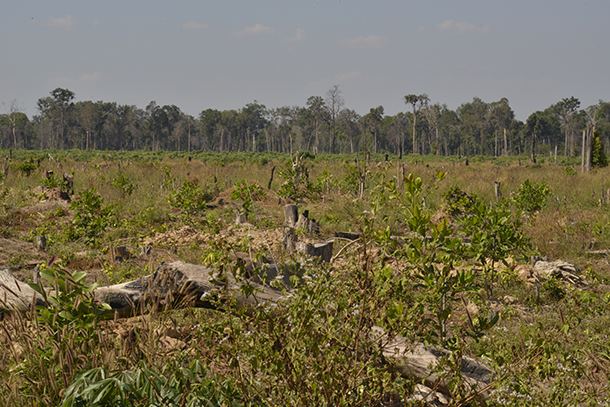
Leng Ouch documented deforestation in Cambodia to show that illegal logging was happening (Photo: Goldman Environmental Prize)
LOURE: There’s a number of National Parks created in the Maasai land, that includes the Serengeti, the Manyara National Park, the Tarangire National Park. These national parks, a big portion of their land was belongs to the pastoralists, Maasai land, and all people has to get out of it.
CURWOOD: So in other words traditional lands for thousands of years, people being pushed off that land because of, supposedly, the national park.
LOURE: Yes, for conservation.
CURWOOD: But your people have been conserving that land for thousands of years.
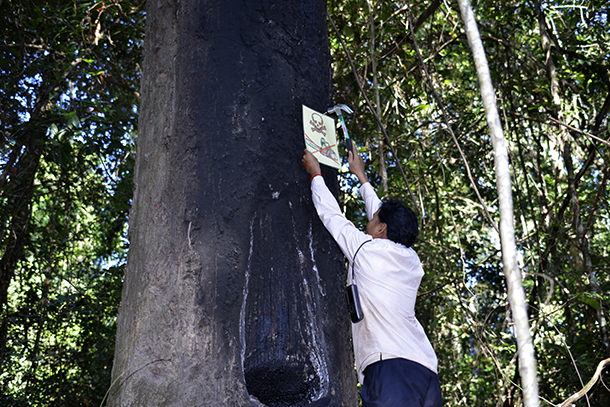
Ouch won the Goldman Prize for stopping illegal logging on over 200,000 acres of land (Photo: Goldman Environmental Prize)
LOURE: Sure, but now, you know there is movements of conservation with no human face. The people want to have just the conservation land, the human activity’s not allowed. People value more the wild animals rather than community livelihood. These communities have been there for centuries and they know very well how to stay together with these animals and some of the research even shows that you take away these communities, the wildlife number is reduced, because it is difficult for poachers to come and poach animals when somebody’s there.
CURWOOD: So what did you decide to do about this problem?
LURE: After we found that these communities are now outside the protected areas, but still, the small land that they have, it is not secured, it is still insecure, so our big role is to facilitate the securing of these communal lands, to make sure that the land they own now has to be more secured.
CURWOOD: Studies show that when indigenous people are able to secure land rights, it generally leads to greater conservation of natural habitats. In the fight to ensure that the pastoralists and hunter-gatherers in Tanzania had a legal title to the land they were living on, Edward Loure and his colleagues read up on property law in Tanzania.
They discovered that they could apply for something called a Certificate of Customary Right of Occupancy (or CCRO), which would grant entire villages communal land rights. Land in Tanzania is typically held by a single property owner, but the CCROs would secure the land based on a traditional communal ownership structure.
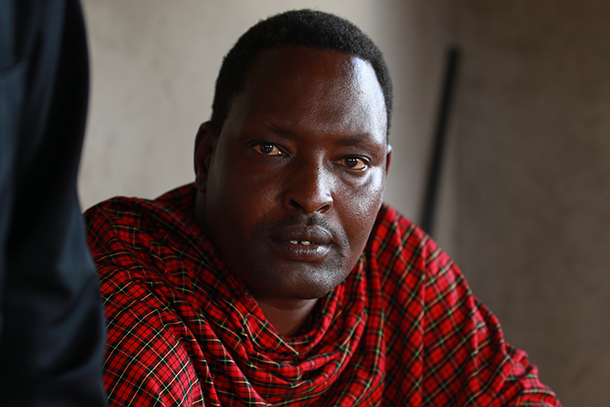
Tanzanian Edward Lourie, 2016 Goldman Environmental Prize winner from Africa (Photo: Goldman Environmental Prize)
LOURE: The pastoralists and hunter-gatherers, their way of life is living communal and use the resources communally. I myself come from the pastoralist community so I know this lifestyle before, these certificates will protect the interests of communal sharing of resources. We tried to convince the government to adopt it. Now they’ve agreed and we want to do it more.
CURWOOD: How much land so far do you think you’ve been able to secure?
LOURE: By end of this year we are going to secure 300,000 hectares of land, and we want to do it more, and I hope also this recognition will also give us room to connect for more donors that can also be supporting us in securing more lands for this community. At this moment we’re only working with 76 communities around the northern part of the country, and there are so many, we want to help them, but due to the limited resources we can’t.
CURWOOD: So what lessons do you think that indigenous people in other parts of the world can learn from your fight?

Loure grew up in a seminomadic Maasai community. He earned the award for securing land rights for the Maasai and other pastoralists (Photo: Goldman Environmental Prize)
LOURE: Having communal land ownership is a very great opportunity for other people to learn around the world because when you secure communal land you wil also be securing land that will save big group of people, compared to an individual land that belongs to only an individual. And it will be a land that will be more protected by the whole land community, because it belongs to all of them and it will also be a land that will not be easy for someone to sell; it will not be easy for someone to use as a collateral to get money in the bank, compared to the individual lands. So you don’t have to think about how do I secure this piece of land for my young children in the future, just to secure community land, it’s done.
CURWOOD: Edward Loure says there are still many indigenous people in Tanzania who need to secure communal land rights but for now he says he’s excited that the work so far is being recognized.
LOURE: I’m really excited because I’ve been doing this work for the decades and I never know whether someone is watching me. And now it happens that somebody is watching me, and he’s really acknowledging what I’m doing, so it’s really great. I did not even expect it before.
CURWOOD: Edward Loure is one of the winners of this year’s Goldman Environmental Prize, really great to talk with you. Thanks.
LOURE: Thank you too.
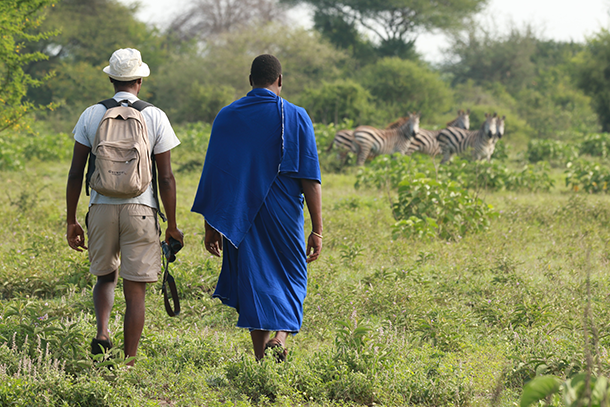
Loure argues that if you want to protect wildlife, the best thing to do is to give stewards like the Maasai control over their own land (Photo: Goldman Environmental Prize)
Related links:
- About Zuzana Caputova
- About Edward Loure
- About Leng Ouch
- Read more about the Goldman Prize
- The 2016 Goldman Environmental Prizes-Part I
- 2016 Goldman Environmental Prize winner Destiny Watford
Puerto Rican Scientist Saves Leatherback Turtles and More from Hotel Development
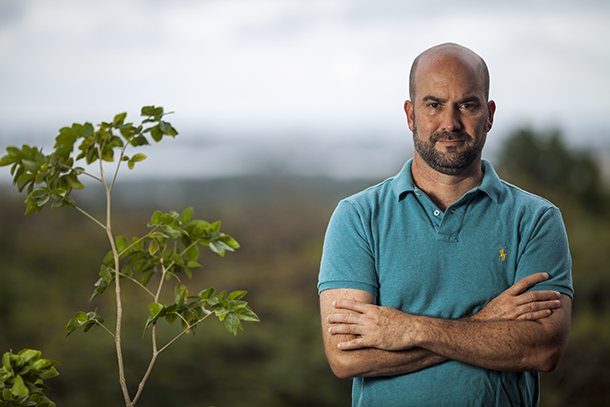
Jorge Luis Rivera Herrera won the 2016 Goldman Prize for island states for protecting the Northeast Biological Corridor, a biodiverse tract of land in Puerto Rico, from hotel development (Photo: Goldman Environmental Prize)
CURWOOD: Of course Puerto Rico is part of the US, but it’s not a state, and this year the Goldman winner for the island territories is Luis Jorge Rivera Herrera, an environmental scientist from Puerto Rico. He won for his work protecting a strip of undeveloped coast in the area of Luquillo beach called the Northeast Ecological Corridor. The hotspot of biodiversity is home to more than 50 at risk species and in the late 90s developers proposed building two giant resorts with room for thousands of tourists. But Luis Jorge and others rallied public opposition to the development in order to protect the region's natural resources and the incredible ecology found in the corridor. Welcome to Living on Earth.
RIVERA HERRERA: Hi, Steve.
CURWOOD: Tell me a bit about this land that you've worked so hard to protect. What is the northeast ecological corridor?
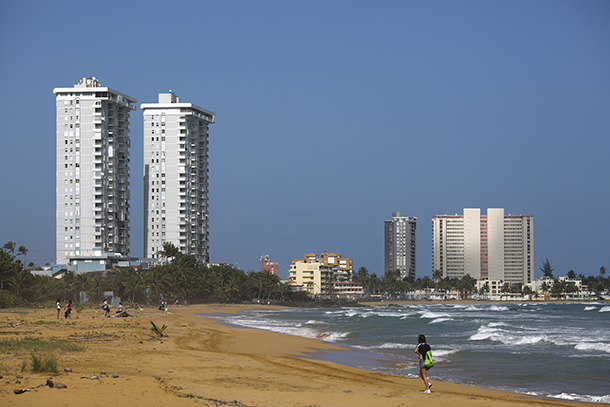
The proposed resorts could have limited public beach access and threatened the region’s wildlife habitat and water supply (Photo: Goldman Environmental Prize)
RIVERA HERRERA: This is a piece of land that extends approximately a thousand acres in the northeastern region of Puerto Rico, specifically in the vicinities of Luquillo and Fajardo. The corridor is possibly best known as one of the best nesting sites for the endangered Leatherback sea turtles in any area within the US jurisdiction. However, the corridor is also important due to all of the habitats that it harbors, for example, there are coral communities, sea grass beds, mangrove forest and even bloodwood swamps which is a type of wetland that is almost endangered in Puerto Rico. Also what makes the corridor really important is its relation with the El Yunque rain forest which is also managed by the US Forest Service because within a very limited space that runs approximately 30 miles inland you can find all six life zone that are in Puerto Rico. Meaning, for example, in the corridor you can find coastal dry forest and at the other end, you can find a tropical mountainous rainforest. And just to put that characteristic into perspective, if you want to see six life zones, let's say here in the US mainland, you will have to travel hundreds if not thousands of miles and on that corner of the island by just traveling 30 miles you can see all that biodiversity.
CURWOOD: You talked about the Leatherback turtles, Luquillo, of course, is famous for its beach, and Fajardo is a popular jumping off places for the offshore islands and the beaches. But the Leatherback turtles are bothered if there are lights on the shore that confuse them in nesting. How were you able to deal with the pressure of development in this area?
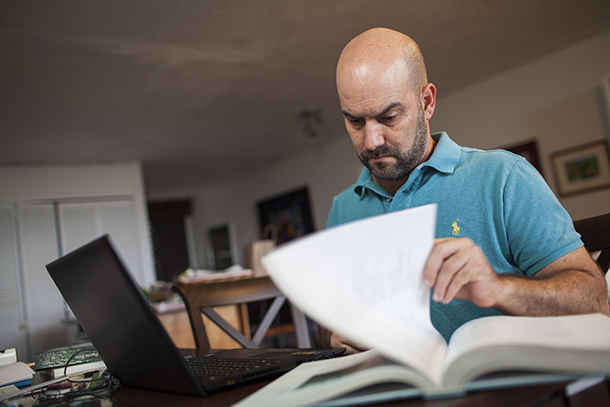
Rivera Herrera first heard about the planned mega-resorts through an ad in a newspaper (Photo: Goldman Environmental Prize)
RIVERA HERRERA: Well, initially, we were trying to bring up to the public's attention, the value of the corridor, and some people sympathized about the need to protect such an extraordinary natural area. But also we had to confront people and make them aware about the impact that the resorts that were being proposed on the corridor would have had on their daily livelihoods. Some of the projects were asking the government to exempt them from providing public access to the beach there in Luquillo and Fajardo and as islanders, we feel a really big connection with our coastal resources. So that didn't sit too well with too many people. The other big impact that the resorts would have had was on the public water supply because especially during the early 2000s, many communities were bad or deficient on the public water supply, so you can imagine what would have happened if over 4,000 hotel and villas would have been built on that same area where many communities were lacking water.
CURWOOD: How much support was there from the people of Puerto Rico to protect this territory?
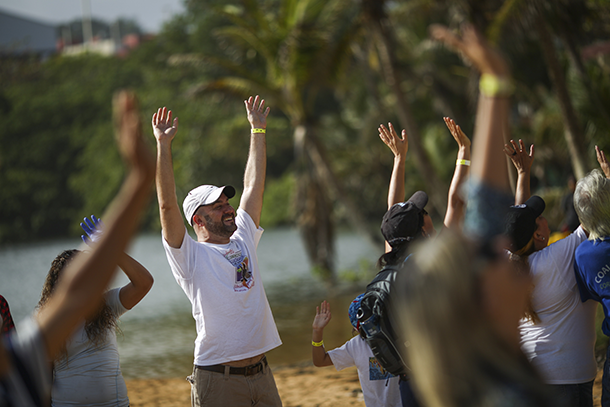
The corridor was recently designated as a protected nature reserve (Photo: Goldman Environmental Prize)
RIVERA HERRERA: Well, that really was what made the difference. At the beginning of our campaign, we were trying to convince the government that building those two resorts was a bad idea, but that didn't work out. Then, we went into courts, and that also helped us gain momentum and especially time in order to promote more citizen participation and attention to the protection of the corridor. One, specific activity that probably was a game-changer was the celebration of a festival that we have been conducting or running for the past 11 years, it's called the Festival el Tingular, or the Leatherback Festival. It revolves around the Leatherback. It is a way to introduce people to the value of the corridor also through cultural activities and music. So, possibly, if there are citizens or people that are not that involved or interested in the protection of natural resources, we can grab their attention through that cultural activity, and they finally become engaged in protecting the area.
CURWOOD: So, how are things now? These resorts weren't built, and the entire corridor along with the turtles that like to come ashore are doing much better?
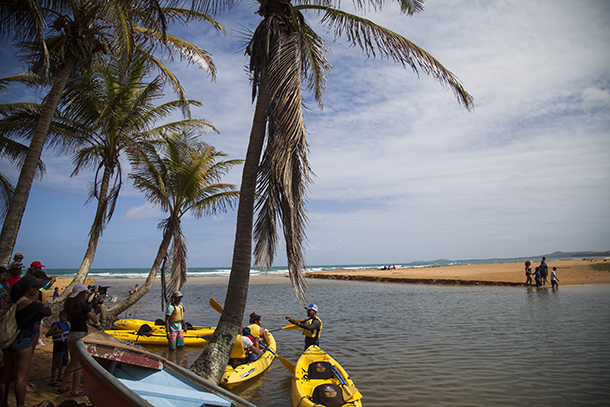
Rivera Herrera wants to see low-impact ecotourism in the corridor so that people can benefit economically while maintaining a healthy ecosystem (Photo: Goldman Environmental Prize)
RIVERA HERRERA: Yeah, definitely. After many years of a struggle, finally in April 2013, the corridor was finally designated by law as a nature reserve. Nevertheless there is a lot of work that still needs to be done. Today, there's still about 30 percent of the lands within the corridor that are still privately owned. So we are also trying to support the government looking into possible sources of financing in order that the government can complete the acquisition of those private lands, so the Puerto Rico Department of Natural and Environmental Resources can manage the whole area comprehensively. We are also working with the local government municipalities in order to develop a participatory or citizen planning process that will also integrate the surrounding communities and downtown Luquillo into whatever economic opportunities could arise as part of ecotourism and tourism activities taking place in the corridor.
CURWOOD: What would you say to other people who are wrestling with the question of balancing development because many people have low incomes in Puerto Rico and protecting the environment?
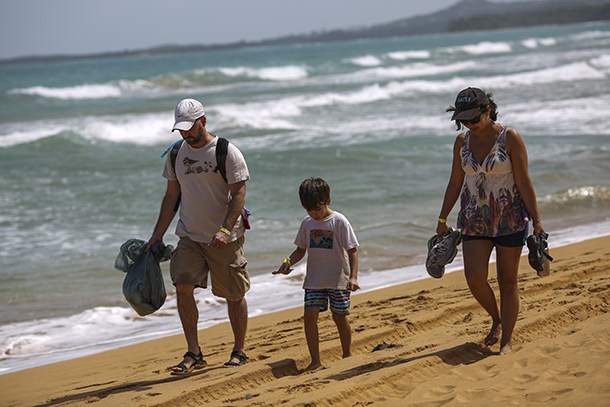
Rivera Herrera hopes his son will be able to surf the waves of the Northeast Ecological Corridor like he did growing up (Photo: Goldman Environmental Prize)
RIVERA HERRERA: Well, first of all, we need to acknowledge that for any kind of development to take place, we need to protect and conserve our natural resources and that doesn't mean that we cannot use them, it's just use them wisely. For example, right now, the island is submerged in a very difficult economic and fiscal situation. There's even a bill that has been filed in the US House of Representatives that will allow this oversight board to repeal any environmental law or regulation in the island in order to supposedly allow and fast track any projects that they deem are important to promote economic development. But if we don't protect our natural resources, for example, we could end up lacking water or having water that has been polluted, and I believe that is something that people from Flint, Michigan, or here in California can relate deeply because if you don't have enough water resources and in good quality you cannot basically develop any kind of activity. So, we need to acknowledge that for development to take place, we need to use our natural resources wisely.
CURWOOD: Luis Jorge Rivera Herrera is an environmental scientist in Puerto Rico and winner of this year's Goldman Prize. Thank you so much.
RIVERA HERRERA: Thank you for your interest and your time.
Related links:
- Read more about Luis Jorge’s work on the Goldman website
- Read more about the corridor
[MUSIC: Charlie Haden/Hank Jones, “It’s Me, O Lord (Standin’ In the Need Of Prayer), Steal Away”, traditional African-American, Verve Records ]
CURWOOD: Living on Earth is produced by the World Media Foundation. Our crew includes Naomi Arenberg, Bobby Bascomb, Jenni Doering, Emmett Fitzgerald, Helen Palmer, Peter Boucher, Adelaide Chen, Jaime Kaiser, Jennifer Marquis and Jolanda Omari. Tom Tiger engineered our show, with help from John Jessoe, Jake Rego and Noel Flatt. Alison Lirish Dean composed our themes. You can find us anytime at LOE.org - and like us, please, on our Facebook page - it’s PRI’s Living on Earth.
And we tweet from @LivingOnEarth. I'm Steve Curwood. Thanks for listening!
ANNOUNCER1: Funding for Living on Earth comes you, our listeners, and from the University of Massachusetts Boston, in association with its School for the Environment, developing the next generation of environmental leaders. And from the Grantham Foundation for the protection of the environment, supporting strategic communications and collaboration in solving the world’s most pressing environmental problems. And Gilman Ordway for coverage of conservation and environmental change. And from SolarCity, America’s solar power provider. SolarCity is dedicated to revolutionizing the way energy is delivered by giving customers a renewable alternative to fossil fuels. Information at 888-997-1703. That’s 888-997-1703.
ANNOUNCER2: PRI. Public Radio International.
Living on Earth wants to hear from you!
Living on Earth
62 Calef Highway, Suite 212
Lee, NH 03861
Telephone: 617-287-4121
E-mail: comments@loe.org
Newsletter [Click here]
Donate to Living on Earth!
Living on Earth is an independent media program and relies entirely on contributions from listeners and institutions supporting public service. Please donate now to preserve an independent environmental voice.
NewsletterLiving on Earth offers a weekly delivery of the show's rundown to your mailbox. Sign up for our newsletter today!
 Sailors For The Sea: Be the change you want to sea.
Sailors For The Sea: Be the change you want to sea.
 The Grantham Foundation for the Protection of the Environment: Committed to protecting and improving the health of the global environment.
The Grantham Foundation for the Protection of the Environment: Committed to protecting and improving the health of the global environment.
 Contribute to Living on Earth and receive, as our gift to you, an archival print of one of Mark Seth Lender's extraordinary wildlife photographs. Follow the link to see Mark's current collection of photographs.
Contribute to Living on Earth and receive, as our gift to you, an archival print of one of Mark Seth Lender's extraordinary wildlife photographs. Follow the link to see Mark's current collection of photographs.
 Buy a signed copy of Mark Seth Lender's book Smeagull the Seagull & support Living on Earth
Buy a signed copy of Mark Seth Lender's book Smeagull the Seagull & support Living on Earth

